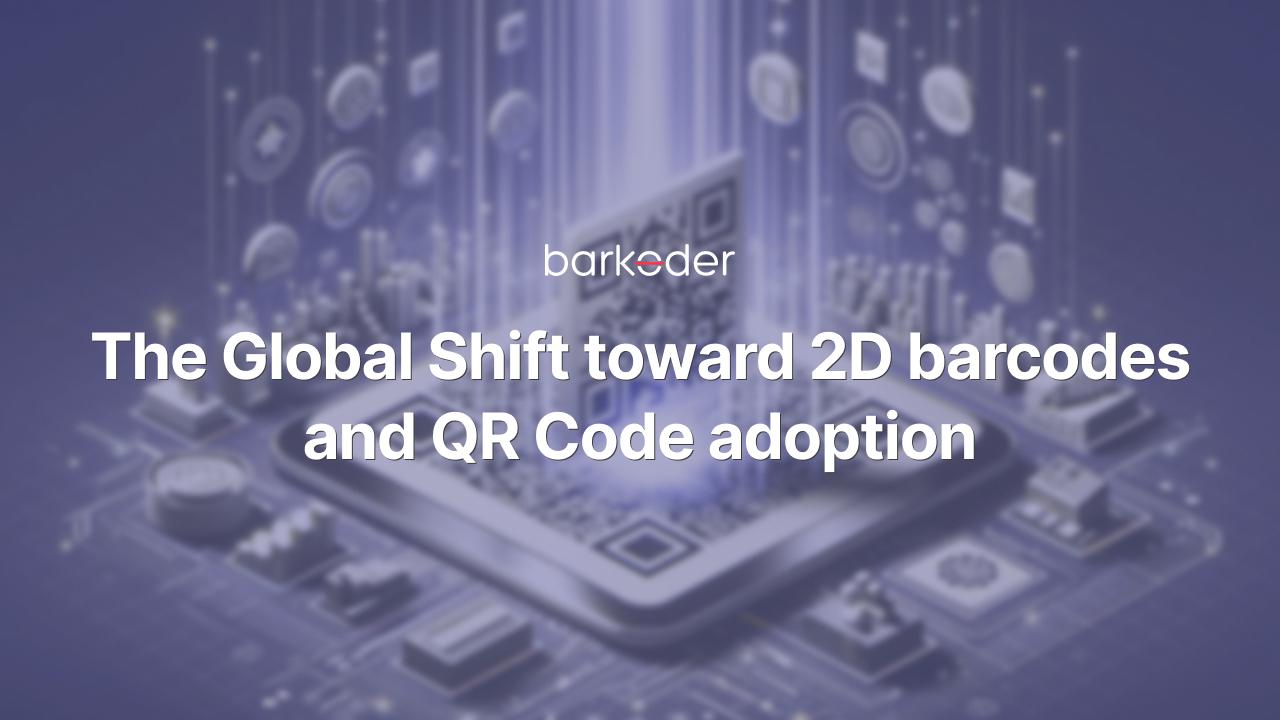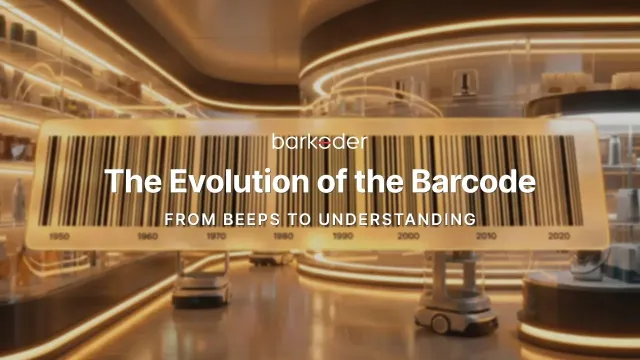
The Global Shift Toward 2D barcodes and QR Code Adoption
For more than 50 years, linear 1D barcodes have been the invisible infrastructure of global commerce. They’ve powered retail checkouts, supply chains, and logistics with a single function: identifying products. But in today’s data-driven economy, that’s no longer enough.
Modern businesses demand more than simple identification — they need instant access to detailed product information, traceability data, and interactive customer experiences. Supply chains now rely on real-time visibility, while consumers expect transparency about origin, sustainability, and authenticity. The traditional 1D barcode, limited to a single string of numbers, can’t keep up with these new expectations.
As industries evolve toward smarter operations and digital transformation, the need for data-rich, scannable solutionshas become critical. This is driving a global shift from linear 1D barcodes to advanced 2D symbols such as QR Codes and Data Matrix, capable of storing hundreds of times more information and unlocking entirely new use cases — from connected packaging and regulatory compliance to direct-to-consumer engagement.
This is where barKoder SDK comes in — a next-generation scanning solution built to bridge the gap between traditional 1D barcodes and the new era of 2D, data-rich symbols. Designed for speed, accuracy, and flexibility, barKoder enables developers and businesses to easily integrate high-performance barcode scanning into any mobile or web application.
With support for all major barcode formats, including QR, Data Matrix, PDF417, and classic 1D symbologies, barKoder delivers reliable decoding even in challenging conditions — poor lighting, curved surfaces, damaged labels, or low-resolution cameras. This level of performance empowers industries like retail, logistics, healthcare, manufacturing, and hospitality to digitize their operations and enhance customer experiences seamlessly.
In a world where every scan counts, barKoder doesn’t just read barcodes — it unlocks the data-driven future of product identity, transparency, and connectivity.
Why 2D QR Codes Are Taking Over
Greater Data Capacity
Unlike traditional barcodes, which only store a simple product identifier, QR codes can carry a wealth of information — from expiration dates, batch and serial numbers, and nutritional facts to traceability data, sustainability details, and even direct links to digital content, websites, or customer engagement platforms.
This added layer of intelligence transforms every product into a digital gateway, connecting the physical world with real-time data and interactive experiences. For brands and businesses, it means greater transparency, stronger consumer trust, and smarter supply chains powered by accurate, instantly accessible information.GS1 Standards Push
GS1, the global organization behind the barcode standards used worldwide, has officially announced the sunset of traditional 1D barcodes by 2027, encouraging industries to transition toward universal 2D code adoption. This marks one of the most significant technological shifts in retail and supply chain management in decades.
Major global retailers — including Aldi, Ocado, and Carrefour — are already running real-world pilots using 2D QR codes on product packaging. These next-generation codes allow retailers and manufacturers to embed far richer data, enabling features such as real-time inventory visibility, automatic recall tracking, and enhanced consumer transparency.
The move toward 2D isn’t just a standards update — it’s the beginning of a smarter, data-connected commerce ecosystem where every scan delivers value not only to businesses but also to consumers.Consumer Familiarity
The pandemic normalized QR usage—restaurant menus, contactless payments, and event tickets made them mainstream. By 2025, 42.6% of US smartphone users are expected to regularly scan QR codes, and nearly 100 million Americans have already done so. (Amra & Elma QR Statistics)Resilient & Reliable
QR codes remain scannable even when damaged, crumpled, or partially obscured, thanks to their built-in error correction capability. This resilience ensures reliable performance in real-world conditions where labels are often exposed to wear, moisture, or rough handling. As a result, QR codes have become the preferred choice for demanding environments such as logistics, healthcare, and manufacturing, where accuracy and uptime are critical.Whether it’s a medical wristband, a shipping label, or a component tag on a production line, the ability to scan instantly — even under challenging conditions — helps maintain operational efficiency and data integrity. This combination of durability, flexibility, and data capacity makes QR codes an essential building block of today’s connected, data-driven workflows.
Vangel Ivanov, CEO of barKoder:
“QR codes are not just an evolution—they’re a revolution. They connect the physical and digital worlds in a single scan. At barKoder, we ensure businesses adopt this standard seamlessly, with technology that’s fast, reliable, and future-proof.”
Industries Leading the Adoption
Retail & Consumer Goods
QR codes connect consumers directly to product stories, providing instant access to sustainability reports, allergen warnings, usage instructions, or recipe ideas. This creates a more transparent and engaging shopping experience, allowing brands to build trust and foster loyalty.
Beyond marketing, QR codes also streamline retail operations. They power self-checkout systems, mobile payments, and contactless interactions, helping stores improve efficiency, reduce queues, and enhance the overall customer experience. By bridging the gap between the physical product and digital information, QR codes are transforming how consumers interact with products while enabling businesses to operate smarter and faster.
Healthcare & Pharma
QR codes connect consumers directly to product stories, providing instant access to sustainability reports, allergen warnings, usage instructions, or recipe ideas. This creates a more transparent and engaging shopping experience, allowing brands to build trust and foster loyalty.
Beyond marketing, QR codes also streamline retail operations. They power self-checkout systems, mobile payments, and contactless interactions, helping stores improve efficiency, reduce queues, and enhance the overall customer experience. By bridging the gap between the physical product and digital information, QR codes are transforming how consumers interact with products while enabling businesses to operate smarter and faster.
Logistics & Warehousing
QR codes provide more detailed tracking for parcels and pallets, enabling real-time visibility across supply chains. Every scan can capture critical information such as shipment status, location, handling instructions, and delivery confirmation. This level of detail improves operational accuracy, reduces errors, and ensures that goods move efficiently from origin to destination.
Additionally, QR codes enhance automation in Warehouse Management Systems (WMS). By integrating scanning directly into inventory workflows, warehouses can automatically update stock levels, track movements, and streamline order fulfillment. This reduces manual labor, speeds up processing, and enables smarter, data-driven logistics operations — all while maintaining complete traceability and accountability throughout the supply chain.
Food & Beverage
Traceability is key in today’s supply chains. QR codes enable regulators, businesses, and consumers to trace items “from farm to fork”, providing detailed information such as origin, lot numbers, production dates, and safety data. This transparency helps ensure compliance with regulations, improves food safety, and builds consumer trust. By making critical data instantly accessible with a simple scan, QR codes create a secure and accountable supply chain, reducing the risk of contamination, fraud, or errors while enhancing overall operational efficiency.
The Technology Behind Seamless 2D Adoption
While 2D barcodes bring immense potential, the real challenge lies in decoding them quickly and accurately at scale. High-volume operations in retail, logistics, healthcare, and manufacturing require scanners that can handle large numbers of items, damaged labels, curved surfaces, and varying lighting conditions without slowing down workflows. That’s where advanced barcode SDKs like barKoder come in.
barKoder is designed to deliver fast, reliable decoding for all major barcode formats, including 1D, QR, Data Matrix, and PDF417. Its robust algorithms ensure that every scan captures data accurately, even in challenging environments, enabling businesses to automate processes, improve efficiency, and unlock the full value of 2D barcode technology. With barKoder, organizations can scale confidently while leveraging the rich data embedded in modern barcodes to power smarter operations and better customer experiences.
MatrixSight for 2D: Enables scanning of QR or Data Matrix barcodes even when they lack some or all their basic elements, and even with severe damages to their matrix cores. Perfect for logistics and shelf inventory.
Specialized DotCode Recognition Mode: The ultimate solution for scanning the small DotCode barcodes. From the creators of the original DotCode software capturing solution.
DPM Mode: Ability to quickly and efficiently scan Data Matrix and QR Codes applied via Direct-Part Marking methods, regardless of surface or technique.
Batch MultiScan coupled with AR Overlays: Enables simultaneous scanning of multiple barcodes in one frame, with options to highlight the scanned barcodes in real-time and even choose which barcodes out of many are to be scanned. Perfect for logistics and shelf inventory.
Vladimir Zivković, CTO of barKoder:
“2D barcodes revolutionize data capture by delivering more context in every scan—in packaging, logistics, and point-of-sale environments. Our technology decodes this complexity in milliseconds regardless of damage and density, keeping operations smooth and informative.”
Preparing for 2027 and Beyond
The transition from 1D to 2D codes is inevitable. GS1’s global 2027 deadline is approaching fast, and organizations that adapt early will be best positioned to take advantage of the benefits:
Increased supply chain visibility
Reduced fraud and counterfeiting
Enhanced customer engagement
Streamlined compliance with regulatory demands
For companies looking to future-proof their infrastructure, 2D barcode adoption is not optional—it’s essential.
Why barKoder Is the Perfect Partner
At barKoder, we’re committed to helping businesses embrace this shift with best-in-class scanning technology. Whether you’re in retail, logistics, healthcare, or manufacturing, our SDK ensures that the adoption of QR and 2D barcodes is smooth, efficient, and cost-effective.
The barcode’s future is 2D—and barKoder is making sure you’re ready for it.






